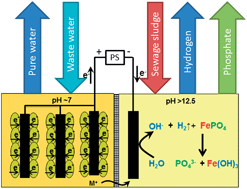Microbial electrolysis cell accelerates phosphate remobilisation from iron phosphate contained in sewage sludge
Abstract
Phosphate was remobilised from iron phosphate contained in digested sewage sludge using a bio-electric cell. A significant acceleration above former results was caused by strongly basic catholytes. For these experiments a dual chambered microbial electrolysis cell with a small cathode (40 mL) and an 80 times larger anode (2.5 L) was equipped with a platinum sputtered reticulated vitreous carbon cathode. Various applied voltages (0.2–6.0 V) generated moderate to strongly basic catholytes using artificial waste water with pH close to neutral. Phosphate from iron phosphate contained in digested sewage sludge was remobilised most effectively at pH ∼13 with up to 95% yield. Beside minor electrochemical reduction, hydroxyl substitution was the dominating remobilisation mechanism. Particle–fluid kinetics using the “shrinking core” model allowed us to determine the reaction controlling step. Reaction rates changed with temperature (15–40 °C) and an activation energy of Ea = 55 kJ mol−1 was found. These analyses indicated chemical and physical reaction control, which is of interest for future scale-up work. Phosphate remobilisation rates increased significantly, yields doubled and recovered PO43− concentrations increased four times using a task specific bio-electric system. The result is a sustainable process for decentralized phosphate mining and a green chemical base generator useful also for many other sustainable processing needs.


 Please wait while we load your content...
Please wait while we load your content...